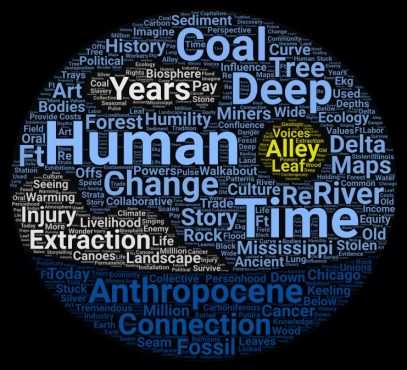UVic professor and Ocean Networks Canada associate take interdisciplinary approaches to science

Word art by Sara Black.
In the coming months, key actors in the ocean and climate community will embrace art’s role in mobilizing scientific research, and two people from Victoria’s art-science scene are taking part.
Dwight Owens and UVic professor Dave Riddell represent just two individuals experimenting at the intersection of art and science. After working at Ocean Networks Canada (ONC) for over 14 and eight years respectively, they have observed the organization become the national network it is today. In the past few years, they have also witnessed the steady integration of art into research practices, not only within ONC but in the scientific community as a whole.
Dave believes this integration of art and science is a response to the United Nations’ (UN) Decade of Ocean Science and Sustainability, a call to action running until 2030 that has inspired many scientists, researchers, and artists alike, to take an interdisciplinary approach to their work. According to some leading research networks, this art-science balance can help “change humanity’s relationship with the ocean” — one of the 10 Decade Challenges put forth by the UN.
“There are expectations that we see some kind of paradigm shift within this decade,” said Dave. “I think a lot of organizations out there have risen to the challenge.”
At the end of November, one such organization, the Marine Environmental Observation, Prediction, and Response Network (MEOPAR), will host its Annual Network Meeting — a yearly conference dedicated to supporting research excellence in ocean protection and coastal community resiliency in Canada. According to Dave, MEOPAR carries weight within the marine-science community, meaning that their Annual Network Meeting will inform further conversations throughout the year.
Dave will take part in this year’s conference by showcasing his self-produced soundscape Last Days of the Pacific in Science-Art Symbiosis, a virtual art exhibition organized by MEOPAR. As the name may imply, Dave’s soundscape focuses on the factors impacting our oceans, including noise pollution, rising temperatures, and acidification.
“I still feel that there’s a place for these more challenging stories and challenging pieces if they stir up emotions in people that can then lead to action,” Dave said, commenting on the difficult themes explored in his piece. “There’s a role for emotions as long as they have somewhere to go.”
The emotional aspect in art-science integration is what Owens and others refer to as the heart in a “head, heart and hands approach,” — a key model in transforming the way researchers and educators approach ecological education. Rather than focusing on logic and emotion as separate phenomena, this approach instead embraces the relational progression from knowing, to caring, to loving, to doing — with a focus on action.
“People protect what they love,” said Owens, referencing the late oceanographer Jacques Cousteau. “Only when [we’ve] developed a sense of care, not just knowledge, will [we] take action.”
As ONC’s artist-in-residence program coordinator and a member of the Ocean ArtScience Community of Practice, Owens has plenty of experience in art-science related projects. In December, Owens and his Community of Practice, a global group sharing “transdisciplinary interactions between ocean art, ocean science, and ocean memory,” will present their collaborative, interdisciplinary project at the American Geophysical Union’s (AGU) Fall Meeting in Chicago.
This global, multi-week project used the Exquisite Corpse process. Starting from a common prompt, each participant creates a series of artworks, which are then passed along to inspire another participant’s next piece. The project, undertaken by nine artists, scientists, and researchers across the world, explores unique interpretations of the Hunga Tonga underwater volcano eruption in 2021. According to an article co-authored by the community, their project illustrates that a diversity of perspectives “can create a richer and more full exploration of extreme ocean events.”
Besides Owens’ project, the AGU’s conference — attended by over 25 000 individuals from over 100 countries — will include a live and virtual art exhibit, as well as a participatory, conference-wide poem. In parallel with scientific contributions, these art practices will explore collective outcomes in understanding the planet and societies’ role in preserving it.
“Science-art initiatives and a lot of the work that [ONC] has done in that respect over the years has helped support, where possible, these large scientific conferences that take place in marine-science,” said Dave, speaking on the benefits of interdisciplinary collaborations. “That’s our primary focus at the moment, [to] have some kind of parallel arts stream alongside science discussions and then find ways to cross-pollinate so they don’t just run parallel but they’re starting to now integrate together.”
The print version of this article contained an error regarding the gender identity of a source. We sincerely apologize for this error and have corrected the online version of the article.








